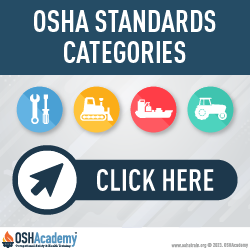What Are OSHA Standards
OSHA standards are rules that describe the methods that employers must use to protect their employees from hazards. There are OSHA standards for Construction work, Agriculture, Maritime operations, and General Industry, which are the standards that apply to most worksites. These standards limit the amount of hazardous chemicals workers can be exposed to, require the use of certain safe practices and equipment, and require employers to monitor hazards and keep records of workplace injuries and illnesses.
The Code of Federal Regulations (CFR) is an annual codification of the general and permanent rules published in the Federal Register by the executive departments and agencies of the Federal Government. It is divided into 50 "titles," of which is Title 29 assigned to the Department of Labor. Under this title, the OSHA standards are organized into sections called 'Parts.'
- Part 1910: General Industry - Includes topics such as hazard communication, walking working surfaces, PPE, powered platforms, hazardous materials, confined space safety, and noise exposure.
- Part 1915: Maritime - Includes topics such as welding, scaffolds, ladders, general working conditions, tools, rigging and material handling.
- Part 1917: Maritime Terminals - Includes topics such as terminal operations, cargo handling gear, first aid and lifesaving facilities, terminal facilities.
- Part 1918: Longshoring - Includes topics such as gangways, working surfaces, opening and closing hatches, cargo handling, vessel cargo handling gear, and gear certification.
- Part 1926: Construction - Includes topics such as exit routes, environmental controls, walking-working surfaces, ladders, fall protection, hazardous materials, PPE, and permit-required confined spaces.
- Part 1928: Agriculture - Includes topics such as safety for agricultural equipment, employee operating instruction, guarding farm field equipment, cotton gins, environmental controls, occupational health.
The Rulemaking Process: Before issuing a standard, OSHA must engage in a thorough process that includes substantial public involvement, along with notice and comment periods. This is known as the OSHA Rulemaking Process.
Knowledge Check Choose the best answer for the question.
1-2. What are OSHA standards?
You forgot to answer the question!

